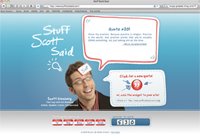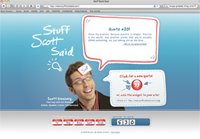 97%.
97%.
According to a 2009 Microsoft Security Report, that’s the percentage of sent emails that are unwanted.
THINK ABOUT IT: If you add up all the spam you received yesterday, plus the hundred or so emails you received from people you don’t know selling you things you don’t want, plus the additional hundred emails from customers, coworkers, superiors, employees, friends and family members that were completely inconsequential and utterly irrelevant to your life, I’d say 97% is fairly accurate.
BUT HERE’S THE QUESTION THAT MATTERS: What’s your strategy for being part of the 3%?
Whether you’re emailing, conversing, tweeting or texting, what – specifically – are you doing to make sure your message don’t end up in the trash?
ANSWER: Not enough.
Today, you’re going to create a filter to make sure your messages are sent in a respectful, approachable and value-driven manner. We’ll explore nine questions to ask yourself before you press the “send” button.
NOTE: As you read them, keep two caveats in mind:
First, don’t ask every question before you send every message. Especially if you’re just pinging somebody who works down the hall. That would either drive you crazy or drive your productivity into the ground. The secret is to increase your awareness of the principles behind these questions.
Secondly, this isn’t about emailing. In fact, emailing is quickly approaching irrelevancy. Ever met someone under twenty-two? They don’t email. According to the students I know, “Email is the new snail mail.” In short: This is about respect. This is about smart communication. And this is about being (not just) approachable – but e-proachable.
I challenge you to think about other channels of communication besides email – Skype, texting, conference calls, meetings, online messaging – where these same ideas can be applied.
1. Have I demonstrated a valid reason for my persistence? The real secret isn’t just being persistent – but demonstrating a valid motivation for your persistence. Otherwise you come off as pushy.
Lesson learned: Set expectational clarity immediately. Punch people in the face with your purpose. Be respectful and intelligent enough to state your reason for messaging within the first two lines or first two seconds.
2. Does this message prove that I care? You can’t bastardize “caring” into a technique. There’s no formula. There’s no handbook. There’s no seven-step system. And it’s not about doing it the right way – it’s more about your willingness to care, you awareness of caring, and consistency with which you do care.
Suggestion: Respond to people’s emotions first. Lead with empathy. Put your person before your profession. It’s amazing: In our increasingly loud, fast and busy world, caring is almost so rare it’s become remarkable. Give it a try.
3. Did I lay a foundation of affirmation? Any message with a fundamentally affirmative orientation is more openable, digestible and memorable. Here are three quick line items:
First, substitute unnecessary apologies for “Thank you.”
Second, preface your answers to inquiries with, “Awesome question!” “Thank God somebody finally asked me that!”
Third, use the two words human beings love more than anything: “You’re right!”
Even if you’re sending an message to inform a guest that his room won’t be ready until they finish scraping the curry stains off the ceiling from last night’s goat sacrifice, these Phrases That Payses insert positivity into even the most negative situations.
4. Is my message low-carb? Joe Friday was onto something. “Just the facts, ma’am” isn’t a one-liner – it’s a lifestyle. Take it from him: Get to the point. Cut to the chase. Don’t waste sentences. Instead, run your message through the filter of MCI, or meaningful concrete immediacy.
Meaningful meaning relevant to the recipient.
Concrete meaning concise and low-carb, aka, “all meat – no potatoes.”
Immediacy meaning applicable and actionable now.
No jargon. No outdated metaphors, bromides or unclear analogies. Zero into the heart of the matter.
5. How have I appealed to self-interest? More specifically: What drives this person? What is this person’s success seed? What is the key to this person’s heart? Who does this person need to look good for? What does this person’s self-interest hinge upon? What could I say in my voicemail that would absolutely piss this person off more than anything?
These are the questions you need to answer to figure out what this person needs to hear to want to hear more.
6. What subject line, header or hook would make me want to open this? Probably something interesting, curious and creative that does not resemble spam in any way. Openable, listenable messages need to appeal to the emotions – and occasionally, the ego – of the other person.
For example, whenever I read a new book that rocks, I email the author. Every time. Normally, my subject line is something like, “13 cool things I learned from reading your book.”
What author could resist? I’m an author myself, and if someone wrote me an email with that subject line, I’d pull over on the side of the interstate just to learn how awesome I am. Next time you send a message, think about what you could say – in this moment – that would be the exact opposite as everyone else.
7. If I waited twenty-four hours to send this message, what would change? Unless it’s a time sensitive issue, consider waiting a day before you press the send button. Maybe you’d edit the message. Maybe you’d completely change the message. Maybe you’d reconsider sending the message at all.
“What a difference a day makes” isn’t a cliché – it’s a reality. Think about it: When’s the last time you heard your coworker say, “Damn it! I really should have overreacted sooner!”
8. Does this email that I’m about to send demonstrate a deep respect for the other person’s most precious commodity? I get a few hundred emails a day. And I’m constantly amazed – almost to the point of being entertained – how often I receive emails from complete strangers who have zero respect for my time.
I’m sorry, but if we’ve never met before, and you can’t tell me what you want in five sentences or less, I’m going to delete your email. Nothing personal. I’m sure you’re a very nice person. And I’m sure your seven hundred word anecdote about how you wound up working in the adult diaper business is a fascinating tale.
But I have books to write.
And I have no remorse about pressing the delete button on a message sent by someone who forgot to press the respect button.
9. What value am I delivering by sending this? If you can’t answer this question, you lose before you even press the send button. Most communications fall under two categories: Value or vanity. Which word describes your messages? Hopefully the latter. Because the goal is to help the other person in a way that she would consider to be substantial.
For example, one of the practices I personally employ on a daily basis is to send a continuous flow of education. Not just information. Any schmo can do that. You need to be a broker of wisdom – an impulsive and compulsive finder and messenger of truth. And you have a responsibility to deliver that truth in a three-dimensional, educational way.
REMEMBER: Whether you’re communicating via email, text, Skype, DM or instant messenger, the rules are all the same.
Be mindful.
Be respectful
Be e-pproachable.
And if you keep these questions in the back of your mind before sending your next message, you’ll earn a spot at the top of your customers’ minds when they receive it.
LET ME ASK YA THIS…
What’s your filter for sending messages to your people?
LET ME SUGGEST THIS…
For the list called, “20 Ways to Make Customers Feel Comfortable,” send an email to me, and I’ll send you the list for free!
* * * *
Scott Ginsberg
That Guy with the Nametag
Author, Speaker, Coach, Entrepreneur
[email protected]
 Who’s quoting YOU?
Who’s quoting YOU?
Check out Scott’s Online Quotation Database for a bite-sized education on branding success!


 Life isn’t fair.
Life isn’t fair. Anybody can start.
Anybody can start. Let’s start with the bad news:
Let’s start with the bad news: Marry Poppins was an entrepreneur.
Marry Poppins was an entrepreneur. Aka, “Stick to it”
Aka, “Stick to it” Who’s quoting YOU?
Who’s quoting YOU? The world’s FIRST two-in-one, flip-flop book!
The world’s FIRST two-in-one, flip-flop book! Thank God for country music.
Thank God for country music.  “I love to cook. And people really seem to enjoy my food. Maybe I should open my own restaurant!”
“I love to cook. And people really seem to enjoy my food. Maybe I should open my own restaurant!”